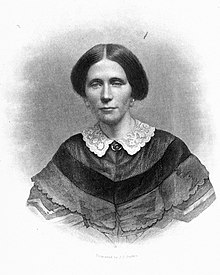Mary L. Day
 From Wikipedia - Reading time: 6 min
From Wikipedia - Reading time: 6 min
Mary L. Day (born 1836, died after 1883) was an American writer, best known for her 1859 memoir Incidents in the Life of a Blind Girl and its 1878 sequel, The World as I Have Found It.
Early life
[edit]Day was born in 1836, in Baltimore, and moved to Michigan with her parents as a small child. They lived in a log cabin until her mother died and her widowed father moved away, leaving the five Day children to the care of other families.[1]
When she was twelve,[2] Day lost her sight in a sudden attack of inflammation. Various interventions were attempted, including surgeries, but she remained blind. A foster family, the Cooks, read to her and taught her to knit. She moved to Chicago at 17, to live with a sister there, and then to Baltimore in search of more help. She enrolled at the Maryland Institution for the Blind in 1855.[1]
Career
[edit]Day was one of a handful of blind authors familiar to American readers in mid-nineteenth-century.[3] She wrote two memoirs, Incidents in the Life of a Blind Girl (1859) and The World as I Have Found It (1878). She sold copies of Incidents to support herself, traveling the United States with a companion,[4] and making personal appearances.[5][6] She also sold her knitting, her beading, and her handwoven baskets. She visited with President James Buchanan, who bought a book from her. She visited with Susan B. Anthony, but the encounter was "cruel", in Day's account, as Anthony scolded her and advocated restrictions on blind marriage and parenthood.[1][3]
The World as I Have Found It carried an introduction by Charles Deems, a noted Methodist preacher.[7] Among the stories in the sequel were her impressions of the Solid Muldoon, a "petrified man" hoax in Colorado.[8] She also traveled to various American cities selling the second book.[9]
Personal life and legacy
[edit]Before 1878, Mary L. Day married a businessman known as "Mr. Arms".[1][7] She was living in Shasta County, California, in 1883.[10] Day's writings continue to be studied as the works of a blind woman in nineteenth-century America.[11][12]
References
[edit]- ^ a b c d "Incidents in the Life of a Blind Girl". Future Reflections. 30 (2). 2011. Retrieved 2020-02-19.
- ^ "The Blind Authoress". The Butte Weekly Miner. 1884-06-11. p. 2. Retrieved 2020-02-19 – via Newspapers.com.
- ^ a b Freeburg, Ernest (2002). "The Meanings of Blindness in Nineteenth-Century America" (PDF). Proceedings of the American Antiquarian Society: 140–142, 148–149.
- ^ "A Blind Authoress". Helena Weekly Herald. 1884-08-14. p. 8. Retrieved 2020-02-19 – via Newspapers.com.
- ^ "A Blind Girl's Book". The Vicksburg Herald. 1869-02-05. p. 3. Retrieved 2020-02-19 – via Newspapers.com.
- ^ "A Blind Girl's Book". Detroit Free Press. 1867-11-28. p. 1. Retrieved 2020-02-19 – via Newspapers.com.
- ^ a b "City and General Items". Daily Arkansas Gazette. 1878-12-10. p. 4. Retrieved 2020-02-19 – via Newspapers.com.
- ^ Rose, Mark (November–December 2005). "When Giants Roamed the Earth". Archaeology Magazine. 58 (6). Archived from the original on 2020-08-03. Retrieved 2020-02-19.
- ^ "Local Brevities". Los Angeles Herald. 1881-05-22. p. 3. Retrieved 2020-02-19 – via Newspapers.com.
- ^ "Local Items". Ferndale Enterprise. 1883-07-20. p. 3. Retrieved 2020-02-19 – via Newspapers.com.
- ^ Clark, Justin (2014). "The Origins of Blind Autobiography in Visionary Antebellum New England". The New England Quarterly. 87 (2): 228–251. doi:10.1162/TNEQ_a_00368. ISSN 0028-4866. JSTOR 43285076. S2CID 57569555.
- ^ Klages, Mary (1999). Woeful Afflictions: Disability and Sentimentality in Victorian America. University of Pennsylvania Press. ISBN 978-0-8122-3499-2.
 KSF
KSF